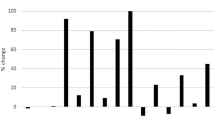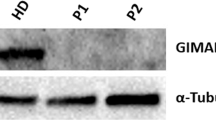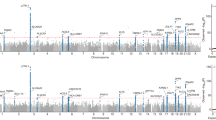Abstract
MD-2 is an accessory protein of the Toll-like receptor (TLR)-4, necessary for assembling a receptor complex to sense low quantities of lipopolysaccharide in order to subsequently trigger innate immune responses. MD-2 and TLR-4 are expressed on a variety of immunocompetent cells. Mutations within the TLR-4 gene have been shown to attenuate immune responses against lipopolysaccharide in mice. In humans, a TLR-4 polymorphism has been associated with a higher risk for developing severe Gram-negative sepsis and with a lower risk for atherosclerosis. Since MD-2 is an essential part of the lipopolysaccharide receptor complex, we screened 20 patients that underwent surgical cancer therapy for novel MD-2 mutations by a single-strand conformation polymorphism technique. In one patient we found an A → G substitution at position 103, resulting in an amino-acid exchange from Thr 35 to Ala. Reporter gene assays revealed that this mutation resulted in a reduced lipopolysaccharide-induced signaling. The patient displayed an uneventful postoperative course, with the exception of slightly decreased TNF-α levels after in vitro stimulation with LPS as compared to wt patients. Genotyping of a further 41 patients by a newly developed Lightcycler/FRET method failed to detect any additional polymorphism carriers, indicating that this is a rare mutation.
This is a preview of subscription content, access via your institution
Access options
Subscribe to this journal
Receive 6 digital issues and online access to articles
$119.00 per year
only $19.83 per issue
Buy this article
- Purchase on Springer Link
- Instant access to full article PDF
Prices may be subject to local taxes which are calculated during checkout





Similar content being viewed by others
References
Akira S, Takeda K, Kaisho T . Toll-like receptors: critical proteins linking innate and acquired immunity. Nat Immunol 2001; 2: 675–680.
Medzhitov R, Janeway Jr C . Innate immunity. N Engl J Med 2000; 343: 338–344.
Janeway Jr CA, Medzhitov R . Innate immune recognition. Annu Rev Immunol 2002; 20: 197–216.
Schumann RR, Leong SR, Flaggs GW, Gray PW, Wright SD, Mathison JC et al. Structure and function of lipopolysaccharide binding protein. Science 1990; 249: 1429–1431.
Ulevitch RJ, Tobias PS . Receptor-dependent mechanisms of cell stimulation by bacterial endotoxin. Annu Rev Immunol 1995; 13: 437–457.
Barton GM, Medzhitov R . Toll-like receptors and their ligands. Curr Top Microbiol Immunol 2002; 270: 81–92.
Yoshimura A, Lien E, Ingalls RR, Tuomanen E, Dziarski R, Golenbock D . Cutting edge: recognition of Gram-positive bacterial cell wall components by the innate immune system occurs via Toll-like receptor 2. J Immunol 1999; 163: 1–5.
Michelsen KS, Aicher A, Mohaupt M, Hartung T, Dimmeler S, Kirschning CJ et al. The role of toll-like receptors (TLRs) in bacteria-induced maturation of murine dendritic cells (DCS). Peptidoglycan and lipoteichoic acid are inducers of DC maturation and require TLR2. J Biol Chem 2001; 276: 25680–25686.
Kirschning CJ, Schumann RR . TLR2: cellular sensor for microbial and endogenous molecular patterns. Curr Topics Microbiol Immunol 2002; 270: 121–144.
Takeuchi O, Hoshino K, Kawai T, Sanjo H, Takada H, Ogawa T et al. Differential roles of TLR2 and TLR4 in recognition of Gram-negative and Gram-positive bacterial cell wall components. Immunity 1999; 11: 443–451.
Poltorak A, He X, Smirnova I, Liu MY, Van Huffel C, Du X et al. Defective LPS signaling in C3H/HeJ and C57BL/10ScCr mice: mutations in Tlr4 gene. Science 1998; 282: 2085–2088.
Shimazu R, Akashi S, Ogata H, Nagai Y, Fukudome K, Miyake K et al. MD-2, a molecule that confers lipopolysaccharide responsiveness on Toll-like receptor 4. J Exp Med 1999; 189: 1777–1782.
Nagai Y, Akashi S, Nagafuku M, Ogata M, Iwakura Y, Akira S et al. Essential role of MD-2 in LPS responsiveness and TLR4 distribution. Nat Immunol 2002; 3: 667–672.
Visintin A, Mazzoni A, Spitzer JA, Segal DM . Secreted MD-2 is a large polymeric protein that efficiently confers lipopolysaccharide sensitivity to Toll-like receptor 4. Proc Natl Acad Sci USA 2001; 98: 12156–12161.
Smirnova I, Hamblin MT, McBride C, Beutler B, Di Rienzo A . Excess of rare amino-acid polymorphisms in the Toll-like receptor 4 in humans. Genetics 2001; 158: 1657–1664.
Arbour NC, Lorenz E, Schutte BC, Zabner J, Kline JN, Jones M et al. TLR4 mutations are associated with endotoxin hyporesponsiveness in humans. Nat Genet 2000; 25: 187–191.
Lorenz E, Mira JP, Frees KL, Schwartz DA . Relevance of mutations in the TLR4 receptor in patients with gram-negative septic shock. Arch Intern Med 2002; 162: 1028–1032.
Kiechl S, Lorenz E, Reindl M, Wiedermann CJ, Oberhollenzer F, Bonora E et al. Toll-like receptor 4 polymorphisms and atherogenesis. N Engl J Med 2002; 347: 185–192.
van Deventer SJ . Cytokine and cytokine receptor polymorphisms in infectious disease. Intens Care Med 2000; 26 (Suppl 1): S98–S102.
Latz E, Visintin A, Lien E, Fitzgerald KA, Monks BG, Kurt-Jones EA et al. Lipopolysaccharide rapidly traffics to and from the Golgi apparatus with the toll-like receptor 4-MD-2-CD14 complex in a process that is distinct from the initiation of signal transduction. J Biol Chem 2002; 277: 47834–47843.
Abraham LJ, Kroeger KM . Impact of the -308 TNF promoter polymorphism on the transcriptional regulation of the TNF gene: relevance to disease. J Leukoc Biol 1999; 66: 562–566.
Wilson AG, di Giovine FS, Blakemore AI, Duff GW . Single base polymorphism in the human tumour necrosis factor alpha (TNF alpha) gene detectable by NcoI restriction of PCR product. Hum Mol Genet 1992; 1: 353.
Sieling PA, Modlin RL . Toll-like receptors: mammalian ‘taste receptors’ for a smorgasbord of microbial invaders. Curr Opin Microbiol 2002; 5: 70–75.
Imler JL, Hoffmann JA . Toll receptors in Drosophila: a family of molecules regulating development and immunity. Curr Top Microbiol Immunol 2002; 270: 63–79.
Viriyakosol S, Tobias PS, Kitchens RL, Kirkland TN . MD-2 binds to bacterial lipopolysaccharide. J Biol Chem 2001; 276: 38044–38051.
Lorenz E, Mira JP, Cornish KL, Arbour NC, Schwartz DA . A novel polymorphism in the toll-like receptor 2 gene and its potential association with staphylococcal infection. Infect Immun 2000; 68: 6398–6401.
Kato K, Morrison AM, Nakano T, Tashiro K, Honjo T . ESOP-1, a secreted protein expressed in the hematopoietic, nervous, and reproductive systems of embryonic and adult mice. Blood 2000; 96: 362–364.
Kadowaki N, Ho S, Antonenko S, Malefyt RW, Kastelein RA, Bazan F et al. Subsets of human dendritic cell precursors express different toll-like receptors and respond to different microbial antigens. J Exp Med 2001; 194: 863–869.
Mullen GE, Kennedy MN, Visintin A, Mazzoni A, Leifer CA, Davies DR et al. The role of disulfide bonds in the assembly and function of MD-2. Proc Natl Acad Sci USA 2003; 100: 3919–3924.
Kawasaki K, Nogawa H, Nishijima M . Identification of mouse MD-2 residues important for forming the cell surface TLR4-MD-2 complex recognized by anti-TLR4-MD-2 antibodies, and for conferring LPS and taxol responsiveness on mouse TLR4 by alanine-scanning mutagenesis. J Immunol 2003; 170: 413–420.
Stamme C, Muller M, Hamann L, Gutsmann T, Seydel U . Surfactant protein a inhibits lipopolysaccharide-induced immune cell activation by preventing the interaction of lipopolysaccharide with lipopolysaccharide-binding protein. Am J Respir Cell Mol Biol 2002; 27: 353–360.
Visintin A, Latz E, Monks BG, Espevik T, Golenbock DT . Lysines 128 and 132 enable LPS binding to MD-2, leading to Toll-like receptor 4 aggregation and signal transduction. J Biol Chem 2003; 278: 48313–48320.
Acknowledgements
This work was supported by the Bundesministerium für Bildung und Forschung (BMBF, CAPNetz, Project C5) and the Deutsche Forschungsgemeinschaft (DFG) to RRS (Schr 726/1-1). We would like to thank Olfert Landt (TIB MOLBIOL, Berlin, Germany) for designing primers and fluorescent probes for Lightcycler/FRET genotyping.
Author information
Authors and Affiliations
Corresponding author
Additional information
All authors disclose any financial interest that are relevant to the research or constitute a conflict of interest.
Rights and permissions
About this article
Cite this article
Hamann, L., Kumpf, O., Müller, M. et al. A coding mutation within the first exon of the human MD-2 gene results in decreased lipopolysaccharide-induced signaling. Genes Immun 5, 283–288 (2004). https://doi.org/10.1038/sj.gene.6364068
Received:
Revised:
Accepted:
Published:
Issue Date:
DOI: https://doi.org/10.1038/sj.gene.6364068
Keywords
This article is cited by
-
TLR4 and MD2 variation among horses with differential TNFα baseline concentrations and response to intravenous lipopolysaccharide infusion
Scientific Reports (2023)
-
Novel mutations in TLR genes cause hyporesponsiveness to Mycobacterium avium subsp. paratuberculosis infection
BMC Genetics (2009)
-
Biased distribution of single nucleotide polymorphisms (SNPs) in porcine Toll-like receptor 1 (TLR1), TLR2, TLR4, TLR5, and TLR6 genes
Immunogenetics (2006)
-
The TLR4 +896 polymorphism is not associated with lipopolysaccharide hypo-responsiveness in leukocytes
Genes & Immunity (2005)
-
LPS, TLR4 and infectious disease diversity
Nature Reviews Microbiology (2005)



